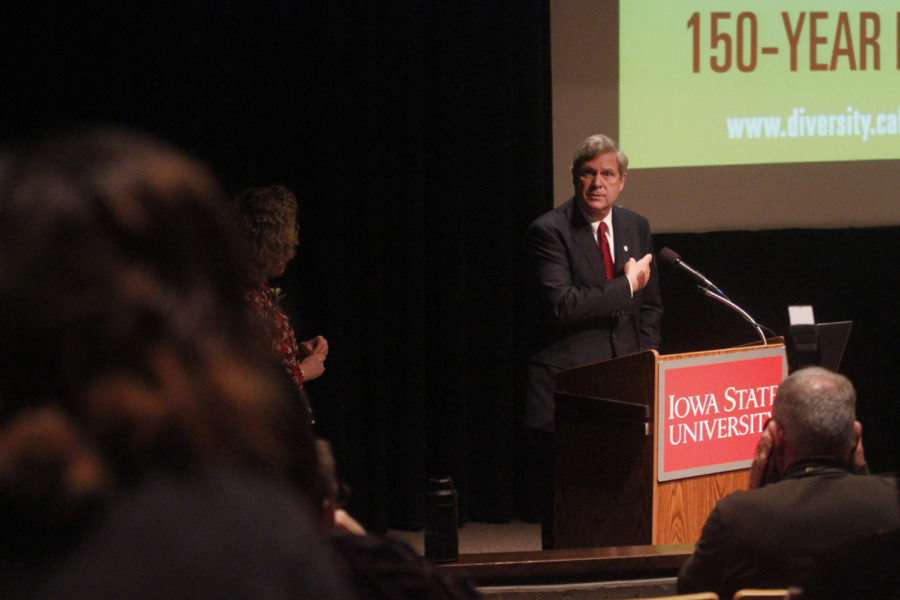Symposium celebrates alumnus George Washington Carver; Speakers show support for new farming research
Tiffany Herring/Iowa State Daily
U.S. Secretary of Agriculture Tom Vilsack speaks at the George Washington Carver Symposium on April 23 at the Scheman Building.
April 23, 2014
Academics and industry leaders discussed ways to increase diversity in agricultural sciences during a daylong symposium to honor the legacy of George Washington Carver, organized by the College of Agriculture and Life Sciences.
The symposium, which took place on the 150th anniversary of Carver’s birth included Tom Vilsack, secretary of agriculture, and Walter Hill, provost at Tuskegee University, as keynote speakers. The symposium’s theme was nurturing Carver’s legacy by retaining diverse students in the agricultural sciences.
“Today is really a celebration as well as a dialogue,” said President Steven Leath in his opening remarks. “It’s actually one of few very significant dates related to agriculture research and extension that have all had great impact on the state and the nation.”
Leath said Carver’s life as a student exemplified what students can do beyond academics in college as he was involved in music, art, debate and the student military regiment.
“[Carver] was and remains a potent symbol of courage, perseverance and a great example of unquenchable thirst for knowledge. We are so proud of Iowa State’s role in shaping his life and how Iowa State continues to shape the lives of students.”
Carver was the first African-American student and faculty member to enroll at Iowa State. Though his exact date of birth is unknown, many historians consider 1864 his birth year.
He later taught and researched at Tuskegee Institute. Carver is noted for his research and promotion of peanuts and sweet potatoes as alternative crops to cotton.
“George Washington Carver represents to me extraordinary resilience,” said Vilsack. “Whenever you are the first of anything, you have got to have remarkable resilience. You have to have the capacity to overcome whatever challenged whatever barriers exist.”
Vilsack talked about the diversity of practice in agriculture. He said the fact that there is a very small fraction of the population involved in national agricultural can be an issue, and it is important to think about opportunities to support small- and middle-sized agricultural operations.
Vilsack said it was important to think about the future of farming as there are fewer young farmers. He talked about the need to help new farmers and touched on the need to fix the immigration system to fill in the labor gap.
The speeches were followed by a panel discussion titled, “Developing the Next G.W. Carver.”
The panel members talked about ways to increase exposure, retain enrollment and ultimately increase contribution by minorities in the agricultural sciences. Ruth MacDonald, professor in the College of Agriculture, said the focus of the panel was to bring forth individual perspectives and the barriers faced by minorities.
“It’s not just recalling what he did but thinking about the future and what we can do to help young people follow in the footsteps to be the next Carver across public and private partnerships to empower and educate innovators,” said Joe Colletti, senior associate dean of College of Agriculture.
He said this was also an opportunity for people from the industry as they depend on institutions for their needs in terms of employees and research.
Students from the sciences demonstrated their research during a poster presentation. Colletti said the poster presentation was an opportunity for students to practice their presentation skills and network.
The symposium at Scheman Building had more than 200 participants from Iowa State, Tuskegee University, Alcorn State University, George Carver National Monument and other institutions.







